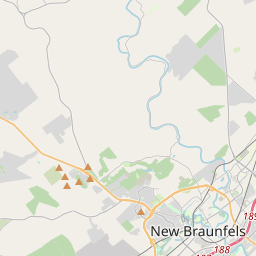International & Great Northern Railroad in New Braunfels
Historical marker location:






As early as 1875, New Braunfels residents began petitioning rail companies to bring lines into the community. The town's first major proposal, to the Galveston, Harrisburg and San Antonio Railroad, failed to achieve the goal. By the end of the decade, however, the International & Great Northern Railroad (I&GN), which had reached Austin in 1876, agreed to bring rail through New Braunfels. By 1880, the town had a depot and the first trains rolled through. In 1885, the rail company built a new depot, which was replaced by a more modern passenger station in 1907.
The railroad dramatically affected the economy of New Braunfels. With the rail outlet, the town could send goods to market and receive products from other cities more effectively. In addition, the railroad sparked tourism in the area, particularly beginning in the late 1890s. It was during this time that Helen Gould, daughter of railroad financier Jay Gould, visited the town. She proposed that the I&GN build a spur track into a beautiful piece of land owned by Harry Landa, which would become known as Landa Park. I&GN built the spur, and soon the park became a popular tourist destination in central Texas, drawing visitors by rail. Today, the park remains the city's primary public recreational site.
In 1926, a subsidiary of the Missouri Pacific Railroad bought out the I&GN and by the middle of the 20th century, the railroad's importance decreased. After merging into the Union Pacific Railroad system in 1986, the Missouri Pacific Railroad donated the 1907 I&GN station to the City of New Braunfels. Today, the former station is home to the New Braunfels Railroad Museum. (2006)
As one of the most visible programs of the Texas Historical Commission (THC), historical markers commemorate diverse topics in Texas history, including: the history and architecture of houses, commercial and public buildings, religious congregations, and military sites; events that changed the course of local and state history; and individuals who have made lasting contributions to the state, community organizations, and businesses.
The Alamo, a mission in San Antonio, is perhaps the most famous historical site in Texas. It was the site of a key battle during the Texas Revolution in 1836.
In the early 19th century, German immigrants began to arrive, attracted by the fertile land and opportunities for a better life. These settlers established small farming communities and brought with them their language, traditions, and expertise in agriculture and craftsmanship. The town of New Braunfels was founded in 1845 by Prince Carl of Solms-Braunfels, becoming the first German colony in Texas.
The mid-19th century saw significant growth and development in Comal County, with the construction of schools, churches, and businesses. The area became known for its thriving agricultural industry, with farmers cultivating crops such as cotton and corn. The arrival of the railroad in the late 19th century further spurred economic growth and provided easier access to markets.
Throughout the 20th century, Comal County continued to evolve and adapt to changing times. The county's strong German heritage remained at the forefront, celebrated through events like Wurstfest, a German sausage festival. The tourism industry also grew, with visitors flocking to the county's natural attractions, such as the iconic Guadalupe River and historic Gruene Hall, Texas' oldest continually operating dance hall.
Today, Comal County is a vibrant and thriving community, blending its rich history with modern amenities and a strong sense of pride in its cultural heritage. With its beautiful landscapes, strong economy, and warm Southern hospitality, Comal County continues to be a desirable place to live and visit.
Comal County Timeline
This timeline provides a condensed summary of the historical journey of Comal County, Texas.
- 1846 - Comal County established as one of the original 23 counties in the state of Texas
- 1847 - Settlement begins in the area with the founding of New Braunfels
- 1850 - Comal County's population reaches 2,013
- 1861-1865 - County residents actively involved in the American Civil War
- 1870 - Completion of the first railroad through Comal County
- 1885 - Jacob's Well, a natural artesian spring, becomes a popular tourist attraction
- 1920s - Economic growth in Comal County, driven by agriculture and manufacturing industries
- 1941-1945 - County residents contribute to the war effort during World War II
- 1968 - Canyon Lake, a reservoir on the Guadalupe River, is completed
- 1990s - Rapid population growth and urban development in Comal County
- 2007 - Construction begins on the controversial Trans-Texas Corridor project